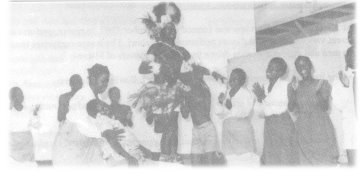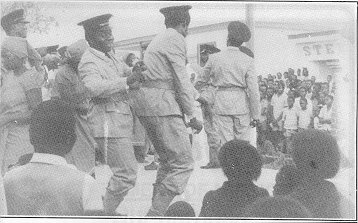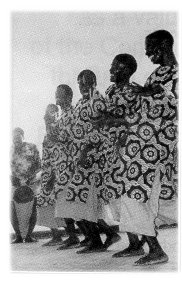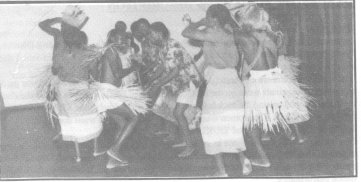 Vimbuza, a popular dance among the Tumbuka of Northern Malawi,
is a healing
dance. It is performed to cure a number of mental and psychological
illnesses.
Vimbuza, a popular dance among the Tumbuka of Northern Malawi,
is a healing
dance. It is performed to cure a number of mental and psychological
illnesses.
DANCES OF MALAWI - A DESCRIPTION
INGOMA
Ingoma is a very famous dance among the NGONI of Mzimba and Mchinji
Districts.
Like Ngoma of Ntcheu and Dedza Districts, it was originally a war dance
performed after a successful battle.
The men in Ingoma are elaborately decorated. Their costume includes
a headgear made of feathers, ornaments worn on the limbs, a network of
beads wrapped across the chest
and stomach, and around the neck hang various types of animal skin.
They carry a spear or club and a shield. The women wear ordinary 'Chilundu'
(a piece of cloth) from the waist downwards, and a blouse and a head gear
called 'DUKU'.
In the Ingoma dance, men dance in straight lines while women form lines
on the side of the men. Men sing and stamp their feet, wielding their shields,
spears and clubs by symbolising a war scene while the women sing, clap
and ulutate in unison with the men's dance performance.
NGOMA
Like Ingoma, Ngoma was originally a war dance performed by the Ngoni
of Ntcheu, and Ngoma is even performed at wedding ceremonies, funerals,
as well as at national occasions, for entertainment.
VIMBUZA
 Vimbuza, a popular dance among the Tumbuka of Northern Malawi,
is a healing
dance. It is performed to cure a number of mental and psychological
illnesses.
Vimbuza, a popular dance among the Tumbuka of Northern Malawi,
is a healing
dance. It is performed to cure a number of mental and psychological
illnesses.
The name Vimbuza also signifies the disease which is mostly widespread
in the Northern
and Central Regions of Malawi and is very common among the women folk.
It is performed by both men and women usually at night in the vicinity
of the afflicted person. However, Vimbuza Dance is also performed purely
for entertainment.
BENI
 Beni dance originated from the two World Wars of 1914 - 1918 and 1939
- 1944. The dance was developed by ex-servicemen, based on the old military parades
performed during the war.
Beni dance originated from the two World Wars of 1914 - 1918 and 1939
- 1944. The dance was developed by ex-servicemen, based on the old military parades
performed during the war.
In the Beni dance, the performers adorn tunics and khaki trousers and wear different types of medals and decorations as it used to be during the wars. Although women did not fight in the wars, in the Beni dance women and young boys take part to give the dancers the necessary musical background.
Beni is most popular among the Yao of Mangochi, Salima and Dedza districts. It is also popular among Malawians working in Zambia and Zimbabwe and there it is known as Kalele dance.
Beni music is usually preceded by a harmonious duet which is followed by a chorus.There are usually three drums and whistles to accompany the singing.
INDINGALA
Indingala is a highly emotional and expressive dance performed by the
Nyakyusa and Ngonde of Karonga and Chitipa districts. It is also performed in Tanzania
where the Nyakyusa and Ngonde lived before immigrating to Malawi.
Indingala is a special drum which was used for sending messages about
the death of a chief, the presence of dangerous animals or an attack by enemy tribes
in the neighbourhood.
Strong men would rush to the scene armed, and if
the message was about the death of a chief, a fight would break out. This
used to be the case because they suspected foul play and custom demanded
that a chief must be laid to rest accompanied by a number of his subjects.
Indingala, therefore, developed as a warrior dance out of this practice.
But today it is a peaceful dance in which people participate to express their emotional
feelings either to release tension or simply to relax.
Sometimes Indangala groups compete with each other. When it is performed
for entertainment, women and children participate. The men wear a long
piece of cloth around the waist and adorn decorations of beads. They paint
their bodies with clay and use flywhisks when dancing. There is very little
singing in Indingala otherwise the only music is provided by three drums
and whistles.
The dancers throw their bodies in different directions gracefully and
majestically. In Indingala it is important to keep the movements of the arms and the
legs co-ordinated.
SENDEMULE
Sendemule is a traditional dance performed by Balambia people of Chitipa
during funerals, chief installation ceremonies and for entertainment.
When Sendemule is performed at funerals, the songs are appropriately mourning songs, and when it is performed at a chief's installation ceremony or when a dangerous animal like a lion is killed, the songs depict triumph. Today Sendemule is performed at most social gatherings where the dancers usually dress casually.
GULE WAMKULU
Also known as 'the Great Dance', Gule Wamkulu is performed at the request
of the village headman on the occasion of funerals of village members,
puberty initiations, and the installation of chiefs, and is part of the
legacy of royal ritual inherited from the Chewa past.
As such, Gule Wamkulu legitimates chiefship by linking it to the old Chewa policies and by reproducing the symbolic elements of an older cultural order.
Gule Wamkulu is today an essential feature of the Chewa countryside. More than a dance forum, it is a men's organisation and ritual system that is woven into the fabric of the community. As a men's organisation, Gule Wamkulu manifests itself in two senses: it is an ancestral dance performed by spirits and animals collectively called 'Zilombo' (animals) which are masked dancers, who perform at the chiefs' invitation in his village. In a less restricted sense, Gule Wamkulu is the widest community of male initiates. Every Chewa boy undergoes initiation and considers himself a member of the Gule Wamkulu society. As a functional tradition, Gule Wamkulu provides the basic ritual needs of both men and women, both officiating at funerals, at puberty initiations, and at the installation of chiefs. As a ritual system, it consolidates a community around local chiefs and impresses on the community the conceptual categories that make its internal composition coherent.
MWINOGHE
In the Chisukwa dialect, the word MWINOGHE literally means 'Let us
enjoy ourselves thoroughly'. Mwinoghe is an instrumental dance that is
popular among people especially school children in Chitipa District of
the Northern Region of Malawi. It has been derived from a ceremonial dance
of Karonga District called INDINGALA which was originally performed by
men brandishing fly-whisks during either the enthrallment of a chief or
feast over a dead marauding lion.
Mwinoghe is a relatively recent dance, having been modified from Indingala between 1953 and 1955. In its original form, Mwinoghe was performed during inter-school competition of traditional dances and as a form of entertainment for distinguished visitors to schools. These days it is also danced on days of international significance like the annual Independence Anniversary celebrations.
Mwinoghe has been developed to its present form and made popular since the attainment of independence. The main percussion instruments used in the dance are one big drum called ING'INA and two smaller ones called TWANA, but sometimes a whistle is used. The dancers line up in two straight lines, boys on one side and an equal number of girls on the other, facing one another. While the girls continue dancing in a standing position with their hands raised up, the boys squat down wringing and twisting their bodies, all to the rythm of the instruments. Mwinoghe is therefore a celebration dance.
The girls wear a piece of cloth tied around the waist and reaching down the ankles with a blouse on top, preferably orange or yellow in colour. The boys wear short sleeved shirts and short trousers on top of which they also wear a piece of cloth tied around their waists. They dance bare foot.
 MANGANJE
MANGANJE
Manganje is an initiation dance performed by the Yao of Machinga, Mangochi,
Zomba and Blantyre Districts. It is performed at the initiation of boys.
When boys (initiates) leave for and come out of the (Jando) enclosure, Manganje dance is performed to celebrate the occasion. Today Manganje is also performed for entertainment.
MALIPENGA
Malipenga is a modern dance for men. It is believed that it was started
by ex-servicemen who developed it from the military parades of the old
Kings African Rifles.
Malipenga started in Nkhata Bay District and spread all over the Northern Region of Malawi. In the Central Region, Mganda, which is a varient of Malipenga is performed in Kasungu, Nkhota kota, Salima, Ntchisi, Dowa and Lilongwe Districts.
A Malipenga group is known as a'Boma'. Each 'Boma' has its own administrative structure. The success of the Boma is the pride of the whole village. The dance is performed for the entertainment on various occasions.
CHILIMIKA
Chilimika (meaning year) is performed mostly by Tonga women and
youth of Nkhata Bay District in the Northern Region. At each
New Year's day, young men and women congregate at the village arena to
entertain the village with Chilimika. It is actually a very humourous dance.
This dance hails the New Year and is performed at the beginning of each New Year. The dance is an imitation of Malipenga which is mostly performed by men.
 Tchopa is a dance originally performed by the Lomwe during tribal wars
as well as at 'Nsembe' (sacrifice offering) ceremonies when a calamity
has struck. During tribal wars, men used to dance informing the folks that
they were back with news of victory.
Tchopa is a dance originally performed by the Lomwe during tribal wars
as well as at 'Nsembe' (sacrifice offering) ceremonies when a calamity
has struck. During tribal wars, men used to dance informing the folks that
they were back with news of victory.
Tchopa is popular in Thyolo, Mulanje and Chiradzulu districts. It is
now mostly performed for entertainment.
NJANO
Njano, like sister dances - Tchopa and Nantongwe, are now normally
performed for entertainment by both men and women. This dance is popular
among the Lomwe of Thyolo and Mulanje.
KAMCHOMA/MAKHANYA/MCHOMA
Kamchoma or Mchoma with sister dance Makhanya, is widely performed
in the Central and Northern Regions of Malawi. It is usually performed
to celebrate a wedding, the birth of a new baby, installation of a new
chief as well as the normal merry making to show happiness.
CHISAMBA
Chisamba is a female initiation ritual which is a compliment of male
initiation in Gule Wamkulu. Its purpose is to turn girls into succulent
women. This takes place at a tree of maiden hood. (Mtengo Wa Anamwali).
Here, girls receive instructions on the protocols of womanhood. This includes
many warnings of the presence of predatory 'males'- men who would look
up to them for sexual satisfaction.
During Chisamba, girls undergo their own transformation into women. They are stripped of their clothes in the insignia of Gule Wamkulu.
The most important insignia is the animal figarine(chingondo) placed on their heads, a representation of a hare, a serpent or an elephant, the three most prestigious beasts of the night. The dance that accompanies this process is also known as Chisamba. It is performed by women, led by a senior woman, usually the chief's sister known as Namkungwi.
During Chisamba (both the initiation and the dance), women who act as the instructors of the young girls snare at them and escort them to the community. Here everyone descends on the chief's courtyard to witness the ceremony.
Chisamba is performed by the Chewa and is very popular in the Central Region of Malawi where the Chewa are found. Chisamba dance is also performed at the funerals of chiefs and important individuals in the village. It is also common to find Chisamba dance being performed for entertainment at important occasions.
NJERERO
Njerero is a sister dance to Chisamba. It is performed at the initiation
of young girls into womanhood. It is very similar to Chisamba in many ways.
BACK TO TOP